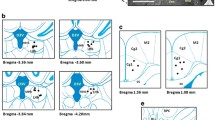Abstract
Ventral tegmental area (VTA) neuronal activity plays an important role in reward-related learning and motivation. Tracing the bursting signal is important for understanding neural state and understanding communication between individual neurons. The dopaminergic system, which projects from the VTA to other regions in the mesolimbic system, is involved in hedonia and motivation. However, the role of this system in the pathophysiology of depression and its manipulation for treatment of depression has received little attention. Inter-spike interval time series were recorded from the VTA of control Sprague–Dawley and Flinders sensitive line (FSL) rats with or without 14 days of desipramine (5 mg/kg) treatment. Comparison of the firing modes of control and desipramine-treated FSL rats reveals dissimilar patterns. Desipramine treatment normalized depressive-like behavior and elevated the dopaminergic mesolimbic activity, although not to control levels. Mesolimbic neuronal activity is known to occur either in burst or in single-spike firing mode. Herein, we suggest a third mode that is characterized as a “cluster” formed from burst and post-burst activity. A significant reduction in the activity of both bursts and cluster was detected in FSL rats, which was restored by desipramine treatment.









Similar content being viewed by others
References
Cooper, D. C. (2002). The significance of action potential bursting in the brain reward circuit. Neurochemistry International, 41, 333–340.
Dremencov, E., Gispan-Herman, I., Rosenstein, M., Mendelman, A., Overstreet, D. H., Zohar, J., et al. (2004). The serotonin–dopamine interaction is critical for fast-onset action of antidepressant treatment: in vivo studies in an animal model of depression. Progress in Neuro-Psychopharmacology & Biological Psychiatry, 28, 141–147.
Dunlop, B. W., & Nemeroff, C. B. (2007). The role of dopamine in the pathophysiology of depression. Archives of General Psychiatry, 64, 327–337.
Friedman, A., Deri, I., Friedman, Y., Dremencov, E., Goutkin, S., Kravchinsky, E., et al. (2007). Decoding of dopaminergic mesolimbic activity and depressive behavior. Journal of Molecular Neuroscience, 32, 72–79.
Friedman, A., Dremencov, E., Crown, H., Levy, D., Mintz, M., Overstreet, D. H., et al. (2005). Variability of the mesolimbic neuronal activity in a rat model of depression. NeuroReport, 16, 513–516.
Gershon, A. A., Vishne, T., & Grunhaus, L. (2007). Dopamine D2-like receptors and the antidepressant response. Biological Psychiatry, 61, 145–153.
Grace, A. A., & Bunney, B. S. (1984a). The control of firing pattern in nigral dopamine neurons: Burst firing. Journal of Neuroscience, 4, 2877–2890.
Grace, A. A., & Bunney, B. S. (1984b). The control of firing pattern in nigral dopamine neurons: Single spike firing. Journal of Neuroscience, 4, 2866–2876.
Overstreet, D. H. (1993). The Flinders sensitive line rats: A genetic animal model of depression. Neuroscience and Biobehavioral Reviews, 17, 51–68.
Overstreet, D. H. (1995). Differential effects of nicotine in inbred and selectively bred rodents. Behavior Genetics, 25, 179–185.
Overstreet, D. H., Friedman, E., Mathe, A. A., & Yadid, G. (2005). The Flinders sensitive line rat: A selectively bred putative animal model of depression. Neuroscience and Biobehavioral Reviews, 29, 739–759.
Schultz, W., & Dickinson, A. (2000). Neuronal coding of prediction errors. Annual Review of Neuroscience, 23, 473–500.
Yadid, G., Gispan-Herman, I., Kesner, Y., Weizman, Y., Mendelman, A., & Zohar, J. (2003). Developing an animal model for post-traumatic stress disorder. European Neuropsychopharmacology, 13, S152–S153.
Zangen, A., Overstreet, D. H., & Yadid, G. (1999). Increased catecholamine levels in specific brain regions of a rat model of depression: Normalization by chronic antidepressant treatment. Brain Research, 824, 243–250.
Acknowledgments
The authors wish to express their gratitude to Prof. Moshe Abeles and Prof. Uziel Sandler for their critical guidance, mathematical, and biological assistance. This study was supported by the Horowitz Foundation to GY. The results of this paper have been patented.
Author information
Authors and Affiliations
Corresponding author
Rights and permissions
About this article
Cite this article
Friedman, A., Friedman, Y., Dremencov, E. et al. VTA Dopamine Neuron Bursting is Altered in an Animal Model of Depression and Corrected by Desipramine. J Mol Neurosci 34, 201–209 (2008). https://doi.org/10.1007/s12031-007-9016-8
Received:
Accepted:
Published:
Issue Date:
DOI: https://doi.org/10.1007/s12031-007-9016-8




